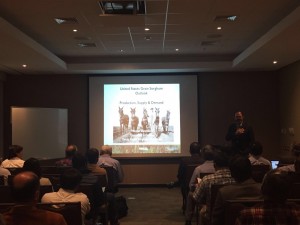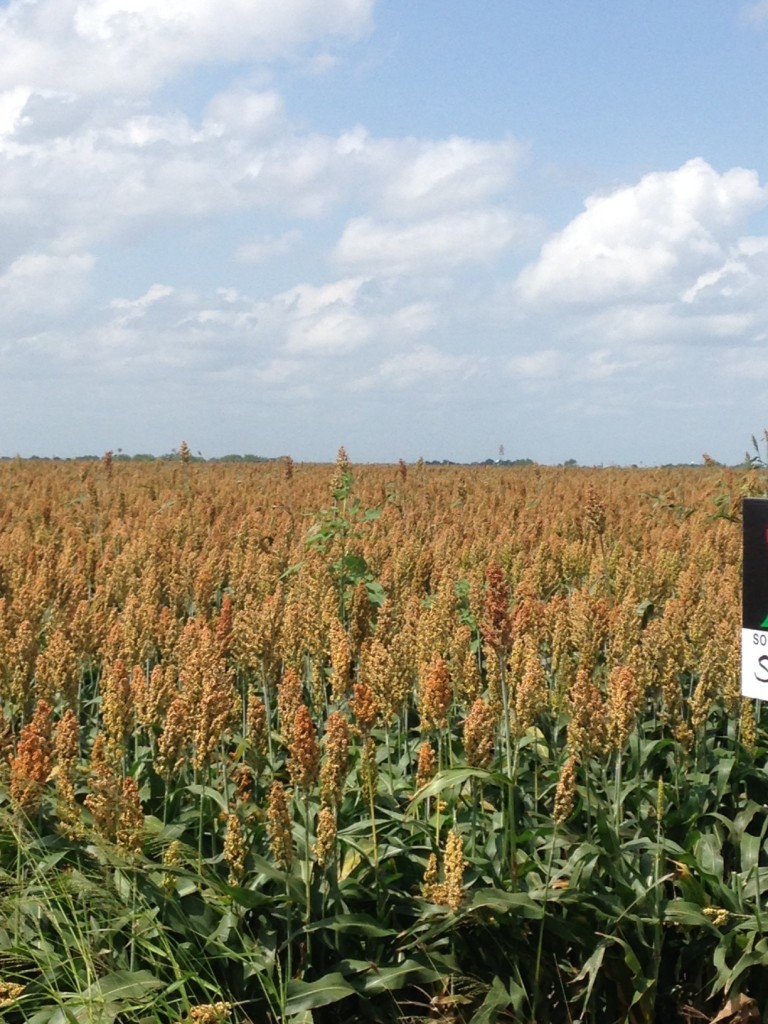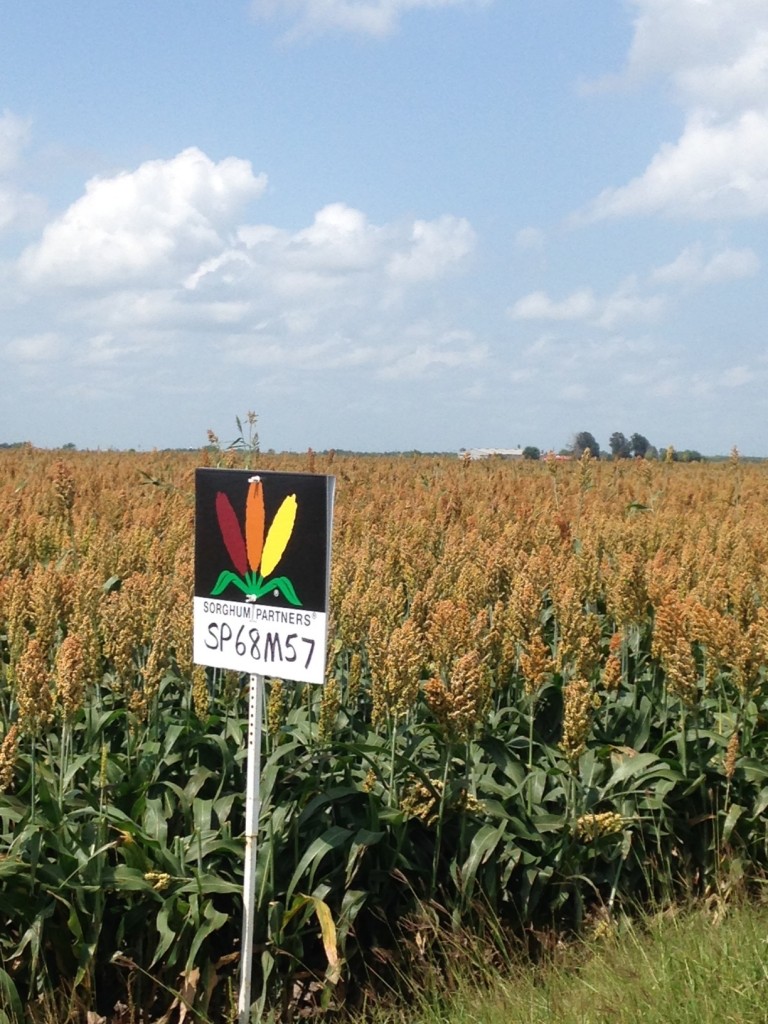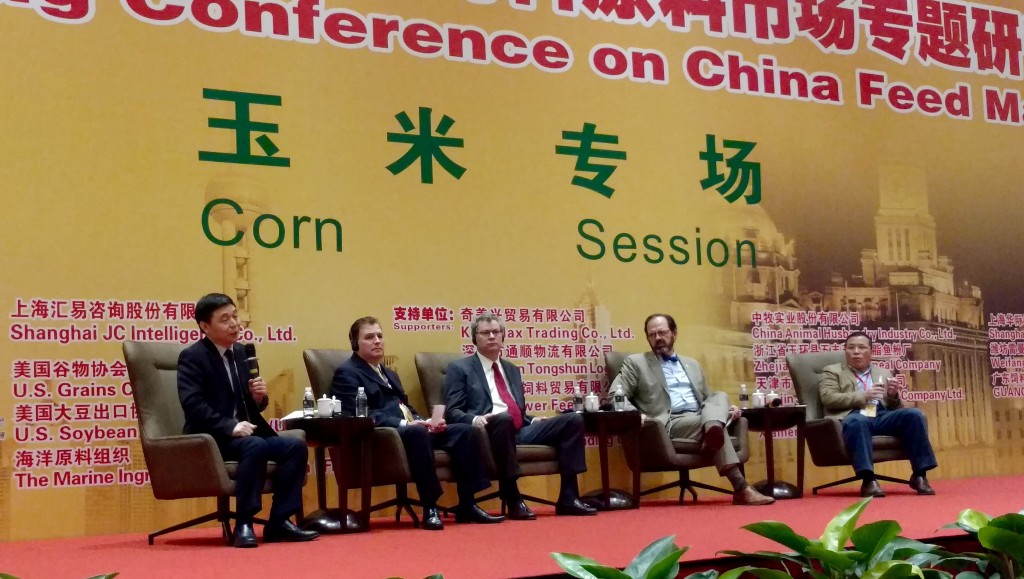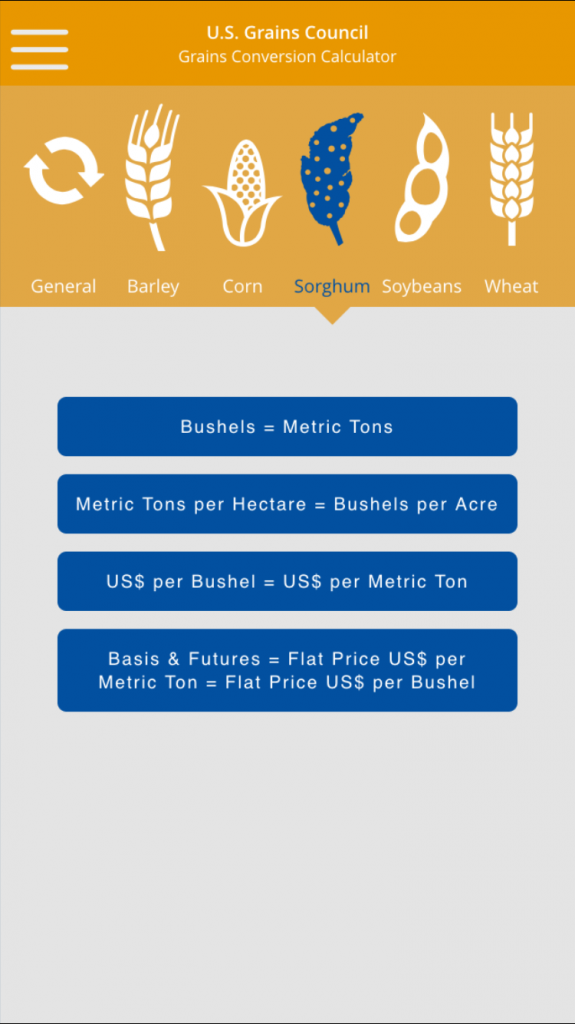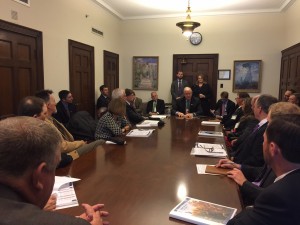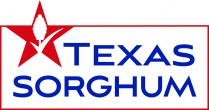- About UsTexas Grain Sorghum Association is….
- Texas Sorghum InsiderNewsletters…
- Legislative News
- Photos
- Contact UsTexas Grain Sorghum Association P.O. Box 905 Salado, TX 76571 Wayne Cleveland, Executive Director wcleveland@mindspring.com (254) 541.5375 Morgan Newsom, Producer Relations Coordinator morgan@texassorghum.org (806) 438.5994 SEND US A MESSAGE: [contact-form-7 404 "Not Found"]
- Sorghum Dashboard
- Events
July 7, 2016
Trade Team Stops in Texas—Last week, Texas Grain Sorghum Producers (TGSP) hosted a team of leading Chinese sorghum importers and feed millers during the trade teams time in Texas. Members of the team were hand-selected by U.S. Grains Council staff in China and represent organizations that purchased 2.5 million metric tons (98 million bushels) of China’s total U.S. sorghum imports in the 2014/2015 marketing year.
“It is vital that Texas Sorghum maintain clear lines of communication and strong relationships with our Chinese end users,” said Wayne Cleveland, TGSP executive director. “This trade mission allowed the team to put a face with sorghum production, to ask producers questions and learn more about effective ways to incorporate sorghum into feed rations.”
During their time here the trade team made stops in South Texas. James Kamas, Clarence Chopelas and Darrell Bowers met with the group and walked through fields, where sorghum was in varying stages leading up to harvest. The producers answered production questions and some of the team members were even able to ride a combine as sorghum was harvested. The team also visited Boening Brothers Diary, where they include popped sorghum in rations. They were also interested in learning more about handling logistics so multiple elevator stops were included as well as a tour of Louis Dreyfus and the Port of Houston.
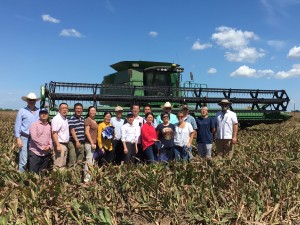
Clarence Chopelas discussed sorghum harvest and farming practices with the team at his farm near Mathis.
A Sticky Situation— One of the more difficult questions our industry faces is how – in light of robust yields and broad international demand – can low farm prices continue to render agriculture operations unprofitable? This question, NSP’s John Duff explains in this year’s spring edition of Sorghum Growers Magazine, begets a series of narrower questions that help to explain why commodity prices remain so sticky and what conditions might engender a more bullish outlook.
In this piece, Duff identifies a handful of variables that, when weighed in relation to commodity price through a process called regression analysis, can explain most of the variance in commodity pricing. The above chart demonstrates how 83% of the variance in commodity prices can be explained by the price of gold. John goes on to show how this analysis can be used to construct a set of upper and lower bounds within which future prices can be expected to fall. It’s important to remember that these findings are predicated on a series of assumptions that are always subject to change. To better understand those assumptions and how they’re projected to affect future commodity prices, read the rest of Duff’s piece here.
Market Perspectives— The following report is from the week ending June 23, 2016. The updated export sales report will be available in next week’s edition of Market Perspectives or on July 8, 2016 via USDA/FAS’ website. Sorghum: Net sales of 84,600 MT for 2015/2016 were down 50 percent from the previous week and 38 percent from the prior 4-week average. Increases reported for China (112,600 MT, including 53,000 MT switched from unknown destinations and decreases of 1,400 MT) and Colombia (25,000 MT), were partially offset by reductions for unknown destinations (53,000 MT). Exports of 56,300 MT were up noticeably from the previous week, but down 33 percent from the prior 4-week average. The destinations were China (53,100 MT) and Mexico (3,200 MT). To read the entire Market Perspectives, provided by the US Grains Council, click here.
Comment Today on Need for Atrazine, Propazine–Atrazine and propazine are under attack by the Environmental Protection Agency. Despite science-based regulations demonstrating the safety of these chemicals for more than 50 years, the EPA’s hyperactive regulatory machine threatens to render these important crop protection tools useless in controlling weeds on 90 percent of the acres in the U.S. Weigh in on how EPA’s draft Ecological Risk Assessments put farmers at an economic disadvantage and submit your own comments before October 4, 2016, at http://sorghumgrowers.com/sorghumalert.
June 24, 2016
Triazine Comment Period Extended—On Tuesday June 21, the Environmental Protection Agency approved the request from NSP and TGSA to extend the public comment period for the recently updated Atrazine, Propazine, and Simazine risk assessments. We are pleased that the EPA was receptive to our plea to appreciate the inherent inequity of demanding that growers take time out of the busy summer season to defend their livelihood. Comments are now due to the EPA on Oct. 4, 2016. In the coming weeks, TGSA will coordinate further action with NSP. We will be engaging our newly formed delegate body – especially the Regulatory Committee – in order to maximize the number of producers voices that are heard. Expect to hear from us with assistance on how to write and submit comments, as well as which talking points to focus on.
Sorghum Feeding Seminars Held in Peru – With 30 million people and a GDP growth rate of 5.1% Peru represents one of the greatest export opportunities of grain sorghum in South America. “Where we see economic growth in a market the first spending increase generally occurs at home with an animal protein enhanced diet,” said Wayne Cleveland. “In the case of Peru, their animal feed operations, as well as dairies, are expanding at a fast pace to service that market.” The two seminars, held in Lima and Trujillo, focused on the use of grain sorghum in feeding rations along with the use of Distillers Dry Grains. On hand to give presentations were nutritionists from Tyson Foods, South Dakota State University and the National University of Mexico. In addition to nutritional information pricing, availability and transportation concerns were addressed by the US Grains Council, Russell Marine Group and the Texas Grain Sorghum Producers. The seminars were sponsored by the US Grains Council and Foreign Ag Service (FAS).
June 8, 2016
Texas Sorghum to Host China Trade Team— A U.S. Grains Council (USGC) trade team of high-volume Chinese sorghum buyers will be in Texas June 27-30 as part of a tour aimed at further developing and strengthening relationships between Chinese sorghum buyers and U.S. suppliers. Members of the team were hand-selected by USGC staff in China and represent organizations that purchased 98 million bushels of China’s total U.S. sorghum imports in the last marketing year. Total commitments to China this marketing year are 260 million bushels with 230 million bushels delivered as of May 26. The team will travel through Central Texas and the Coast making stops near Austin, Odem and Houston. If you would like to meet with the team, please contact Katelyn Luckett, katelyn@texassorghum.org for more information.
EPA Releases Atrazine Risk Assessment—This week, the EPA published its draft ecological assessment in the Federal Register. EPA will be accepting comments until August 5, 2016. After receiving and reviewing public comments, the agency will amend the assessments, as appropriate, the EPA said in a statement. Texas Sorghum will be working closely with National Sorghum Producers to seek input from our grower community, please be on the look out for our call to actions and respond accordingly.
Water Hearing in Austin—On Wednesday June 1, the Texas House of Representatives committee on Natural Resources met to hear public testimony on three interim charges pertaining to water rights and development projects. Although presently Texas is drenched with rainfall, this hearing was intended to address initiatives enacted during the drought of record in 2011 and potential recourses for inevitable future water shortages. Provided testimonies ranged from regulatory agency updates to regional planning group assessments on statutory changes made by past legislatures.
The interim charges on the table Wednesday were broad in nature, primarily asking for legislative oversight on 2015 legislation, joint groundwater planning progress, and ongoing reevaluations of the entire regional and state water planning process. The discussion of agriculture issues was cursory but still respectful of the enormous shadow our industry casts on water planning. Witnesses frequently cited the importance of providing for agriculture and for a healthy regional/statewide balance when crafting water plans.
A large majority of the testimonies were positive and constructive and members were open-handed in their praise for existing water plans and the analysts who construct them. That is not to suggest, however, that all witnesses shied away from criticizing certain elements of the planning and regulatory process. An official from Region A Water Planning Group floated the idea of switching to 10 year regional plans instead of the existing 5 year plans. Bob Harden of the Texas Alliance of Groundwater Owners and Producers censured groundwater districts who illegitimately inverted the planning process by first defining groundwater availability and then constructing models. Mr. Harden alleged that this practice allows entities to regulate “county-by-county” instead of the proper, more broad measures.
This was not the first interim hearing about water rights nor will it be the last. As we draw closer to regular session we will be reaching out to some of our delegate body regarding opportunities to attend hearings and testify about sorghum’s story. I encourage you to read the full list of the House of Representatives interim charges here and reach out to Patrick Wade if you have any comments.
May 27, 2016
EPA Deputy Administrator meets with Texas Group—This week, in an effort to address producers’ ongoing concerns regarding pesticide and insecticide regulation, TGSP invited officials from the EPA to visit sorghum producer Paul Freund’s farm in Needville, Texas. Deputy Administrator Jim Jones and Directory of Chemistry, Economics & Sustainable Strategies David Widawsky joined TGSP staff, Agrilife Extension agents, and representatives from other crops on a tour of Mr. Freund’s operation. Mr. Freund walked the EPA officials through his chemical application practices in an effort to demonstrate how Texas producers prioritize safety and stewardship of the land.
“It’s important that the EPA understands what goes on at an actual farm where their decisions on chemical regulation can have a tremendous effect on profitability and production,” said Executive Director of TGSP Wayne Cleveland. “This is a great step in bridging that gap between producers and the EPA.”
As insecticide labels continue to be pulled, TGSP felt it was important to show the EPA how erratic and dangerous a sugarcane aphid infestation can be. The EPA officials were able to see the proliferate pest firsthand and better understand the pressing need for robust crop protection options. With many of the chemicals best suited for combatting the aphid facing prohibitive regulations, TGSP hoped to communicate the urgency and vigilance that the pest demands from sorghum producers each and every day. South Texas Cotton and Grain (STC&G) Executive Director Jeff Nunley, Ft. Bend Extension Agent John Gordy and CPS officials were also in attendance for the visit. These men echoed the producers’ call for accurate, empirical science and procedural transparency. TGSP is currently working toward sending a group of producers and staff to visit the EPA in Washington DC. The EPA officials who attended said they would be glad to provide the same level of transparency as to the regulatory process as Mr. Freund provided in regard to the application process. Stay tuned for future opportunities to engage with regulatory agencies and help build a more responsive, producer-friendly relationship.
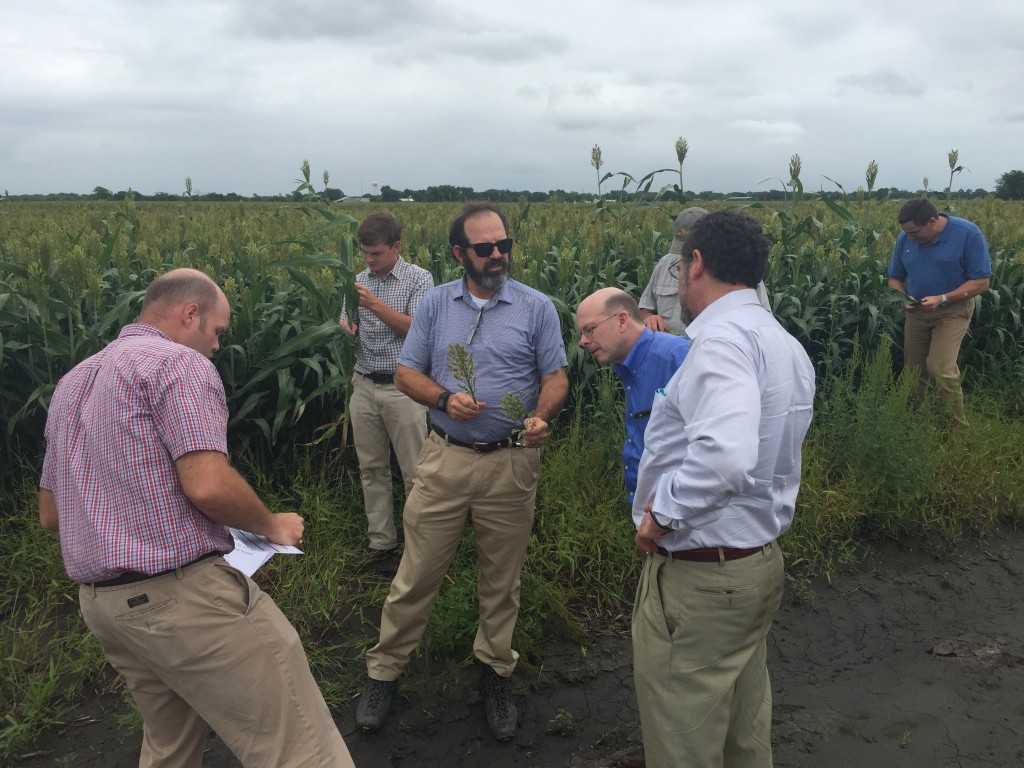
Wayne Cleveland discusses the use of chemicals on farms with EPA Deputy Director, Jim Jones during an farm tour in Needville, Texas.
Valley Sorghum—Harvest in the LRGV is expected gear up next week, below are a few from the field photos.
Monsanto Rejects Bayer’s Buyout Offer—Monsanto has rejected the $62 billion buyout bid from Bayer. The Monsanto board of directors unanimously voted against the offer, calling it “incomplete and financially inadequate.” Monsanto said in a press release it is “open to continued and constructive conversations to assess whether a transaction in the best interest of Monsanto shareowners can be achieved.” Bayer also released a statement saying, “Bayer announced today that it looks forward to engaging in constructive discussions with Monsanto regarding the proposed transaction.” Monsanto’s board of directors said there is no set timeline for when further discussions will take place.
May 11, 2016
Sugarcane Aphid Update—The sugarcane aphid has made an early arrival this season, being found early in South Texas and as far north as the lower Texas Panhandle. Entomologist say although this is concerning, it does not give us any indication of how serious sugarcane aphids may be this season across Texas. Some growers in South Texas began spraying for the aphid last week and are managing the pest with reports indicating populations are low and beneficial insect numbers are increasing. Two products were proven to be very effective during the 2015 growing season – Sivanto Prime and Transform WG. After immense pressure on the Environmental Protection Agency, Texas recently received Section 18 approval for the use of Transform. Dr. Brent Bean, Sorghum Checkoff agronomist, emphasizes the importance of following best management practices, planting early and using treated seed this season, which can prevent early season crop injury from the sugarcane aphid. For additional resources, including best management practices, tolerant hybrids, scouting recommendations and more, click here.
Pesticide Overview—Lately, it seems like not a day can pass without news coming through of the EPA or the courts pulling another valuable crop protection chemical’s label. Despite their wide-reaching impacts, these discussions are typically laden with bureaucratic language, making them less accessible to the general public. To help bridge this gap, Patrick Wade has broken down the two primary recourses producers have to regain access to chemicals whose labels have been pulled:
Section 18 – Pesticide Emergency Exemptions
Should an “urgent, non-routine situation that requires the use of a pesticide” emerge, state or federal agencies may request an emergency exemption for use of an unregistered pesticide. These requests are typically filed in order to avert either a significant economic loss or a significant risk to the environment and/or valuable organisms. Upon receiving this exemption request, the EPA evaluates the validity of the claim, the dietary, occupational, and environmental risks associated, and the pesticide’s present progress towards traditional registration. After a 50-day evaluation, should the claim meet these requirements, the pesticide will be granted one of four exemption statuses:
- Specific Exemption – The most common exemption, occurs when a pest situation is identified that presently registered pesticides are incapable of remedying. The state agency responsible for pesticide management submits the request and the exemption may last up to one year.
- Quarantine Exemption – Occurs when a previously unknown invasive pest appears in the United States. Should the pest’s introduction be proven harmful, this exemption may last up to three years.
- Public Health – Occurs when a pest is determined to cause significant risk to human health. This can last up to one year.
- Crisis – If the need for any of the three aforementioned statuses is proven to be sufficiently immediate, a 15-day crisis exemption may be granted. After the conclusion of that period, one of the three exemptions may be pursued as well.
Section 24(c) – Special Local Need Registration
Another registration exemption afforded by FIFRA is the Special Local Need (SLR) registration, which occurs when a local pest situation cannot be alleviated by presently registered pesticides. Exemptions under this section must meet stricter requirements than those of Section 18. Established tolerance requirements must still be met in this usage, registration for the SLR use cannot have been, at any point, denied or cancelled by the EPA, no unregistered active ingredients can be used, and all registered pesticide options must have been exhausted.
Once cause has been proven, one of two SLNs will be granted: First-Party SLN or Third-Party SLN. The former occurs when the SLN applicant is the registrant of the product, the latter when the applicant is a grower, growers’ association, or anyone other than the registrant.
Once granted by the state agency (the TDA in Texas’s case), an SLR is not subject to a statutory expiration date. The EPA does, however, have 90 days to comment and can ultimately invalidate the exemption.
EPA Finds Glyphosate not Likely Carcinogenic—The Environmental Protection Agency released a report finding the herbicide Glyphosate likely does not cause cancer in humans, disputing the findings by the World Health Organization’s International Agency for Research on Cancer. The EPA’s Cancer Assessment Review Committee made the determination in its finalized report on October 1, 2015, but did not release it to the public until now when the agency mistakenly posted the report online. In the EPA’s review, staffers from the Health Effects Division of the agency’s Office of Pesticide Programs pointed to a number of flaws in the methodology used by the WHO scientists in their review. The WHO finding had serious negative consequences for the agricultural industry and was the basis for California’s decision to require all products containing the herbicide to be listed as carcinogenic. The EPA report was inadvertently posted to Regulations.gov, along with several other glyphosate related documents, on April 29. After the report’s release was widely circulated on social media, the EPA removed the documents on May 2. EPA Spokeswoman Melissa Harrison said the documents were taken down because the assessment is not final. The House Committee on Science, Space, and Technology Chairman Lamar Smith (R-Texas) announced it will investigate why the EPA pulled the report. In a letter sent to the EPA Administrator Gina McCarthy, the Chairman said the agency’s backtracking from the report, which is clearly marked as final, “Raises questions about the agency’s motivation in providing a fair assessment of glyphosate”. Click here to view the final letter and report.
April 26, 2016
TGSA Completes Restructure Process—On April 6, Texas Grain Sorghum Association completed its two-year process of restructuring its board of directors. The association’s governance will now incorporate a delegate body composed of due-paying members throughout the sorghum industry.
“It is gratifying to watch an industry take ownership of self-help programs intended to strengthen our industry and ultimately make sorghum more profitable for producers,” said Dale Murden, President of TGSA.
The newly formed delegate body – made up of Texas producers, elevator managers and corporate members – will now play an active role in TGSA’s operations. Along with representing all regions of the state’s sorghum industry, the delegate body will serve as a pool from which future board members and officers will be drawn. The board of directors is presently composed of ten members (three from each region and one at-large member), with a majority being producers. A survey of the current board and delegate board reveals the association now represents 350,000 acres of production, 265,000 gallons of ethanol production, all major sorghum seed production companies, three elevators, four chemical production companies, and the largest pork production company in Texas. In the coming months TGSA delegates will be assigned to committees ranging from legislative initiatives and regulatory oversight to product innovation and sustainability. In addition to the committee responsibilities, the delegate body will be tasked with approving the TGSA’s annual budget and nominating regional representation to the board of directors. The delegate body will meet as a whole once a year and will have regional meetings intermittently to direct policy and leadership roles. For more information about TGSA’s restructure, governance or membership please contact Patrick Wade at Patrick@texassorghum.org or (512) 788-4599 or Wayne Cleveland at wcleveland@mindpspring.com or (254) 541-5375.

Comptroller Glenn Hegar addresses the crowd during dinner at the first Texas Sorghum joint annual meeting.
TGSA Visits EPA—Patrick Wade joined citrus producers from around the country in a visit to Washington, D.C., last week to discuss crop protection with policymakers and regulatory agencies. The meetings primarily focused on the evolving dialogue between beekeepers and producers regarding the nature and impact of neonicotinoids on the honeybee population. While the group was able to find allies on Capitol Hill who have pledged to defend an empirical approach to pesticide usage, the regulatory agencies were resolute in their insistence that the agriculture industry must do a better job of communicating with the beekeeper groups. While we may disagree with the proportionality of this burden, we are committed to expanding and enhancing our communication efforts moving forward. We were reminded once again during this visit that the single most valuable political asset we have is our story. If we can authentically communicate how chemicals are applied and the personal stake and pride you all have in producing safe crops in healthy environments, then we can preempt activist’s slandering and demagoguery. We encourage you to keep an eye out for upcoming TGSA initiatives to get your story told.
TGSP Hosts Micro Sorghum Seminar—Last week TGSP hosted a micro sorghum seminar in Panama City, Panama. Latin American grain buyers attending the conference heard from swine and beef nutritionists regarding the most effective ways and benefits of sorghum inclusion in feed rations. Texas sorghum producers and elevator managers attending the seminar gave crop outlook and planting progress updates across the state and fielded questions regarding planting intentions for the crop.
“I believe meaningful connections were made during this trade mission,” said Wayne Cleveland, executive director of TGSP. “Latin America, and Mexico in particular continue to be a steadfast market place for Texas sorghum. We greatly value the partnership we have with these buyers and this conference has opened more pathways for grain trade in the future.”
The group had the opportunity to tour the Panama Canal where an expansion is slated to be complete June 26 of this year. The project will create a new lane of traffic through the construction of a new set of locks, doubling the waterway’s capacity. This will allow a huge new increase of barges to go through the Canal and shorten their route by 8000 miles. Currently, about 14,000 ships pass through the Canal yearly—some undoubtedly carrying grain produced by the farmers visiting last week.
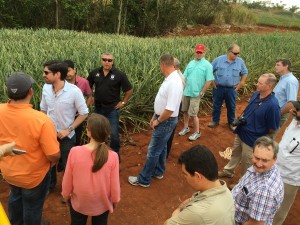
Seminar attendees discuss farming practices with the owner of a pineapple plantation outside Panama City, Panama.
March 31, 2016
Texas Looks for Opportunity in Cuba-Today, the Texas House will host a joint hearing between the Committee on Agriculture and Livestock and the Committee on International Trade and Intergovernmental Affairs regarding the opportunities Texas has to promote its agriculture products domestically and internationally. There will be specific emphasis on potential opportunities for trade with Cuba, and our legislative analyst Patrick Wade will deliver testimony on the subject and his personal experiences traveling to the embargoed country last month. Representatives from the rice, wheat, and cattle genetics industries will join Patrick as they weigh the benefits of free trade with Cuba. Cuba has, of course, been under an embargo since 1962, but in 2000 certain narrowly restricted agriculture products were allowed to be exported, along with medical devices and some other goods. This hearing is coming right on heels of President Obama’s visit to the island country last week, where he announced he was ending the restriction on industry-funded checkoff programs spending money on Cuban market research and development. Today marks the first hearing from the House Agriculture committee during the interim and will address one of their six charges from Speaker Joe Straus. For a full list of interim charges, click here.
Chinese Customers Praise Grain Sorghum as a Feed Ingredient-Despite recent reports of deep reform in Chinese “carry-out policy” that has allowed their government to amass somewhere between 4.3 mm bu (USDA estimate) & 9.8 mm bu (private estimate) of corn into reserves, Chinese end-users continue to purchase US grain sorghum. The country whom consumes a whopping 590 mm bu of feed grains monthly, continually expressed to a group, sponsored by the US Grains Council last week, their attraction to grain sorghum stems from it’s “enhanced” nutritional factors in swine and duck rations. Particularly highlighted was the quality of pork that fit into a higher-end market and the enhanced growth of ducks when using grain sorghum. “Chinese end-users primarily wanted to know what acreage would be for the coming year as well as quality and availability”, said TGSB Executive Director Wayne Cleveland, who accompanied the group. Cleveland served on a panel that discussed US grains supply and demand as well as provided a platform for approximately 500 end-users to ask questions regarding the US grain sorghum industry. “With the recent policy announcement by the Chinese government we need to keep steadfast in our minds that we can’t rely on one market to prop up our industry,” Cleveland continued. “We must be diligent in finding and servicing both domestic and foreign markets that are willing to utilize grain sorghum. China gave us a great pricing and acreage expansion opportunity as well as the ability to showcase our product – they like it’s feed values and want to purchase, now its time for us to find the next big market.”
March 10, 2016
USGC Introduces Conversion App—The U.S. Grains Council (USGC) recently released a grains conversion calculator app and a U.S. grains-in-all-forms exports portal to help members of the global grain trade access critical information more easily. The Council’s grains conversion app converts English units to metric units and vice versa for grains and related measures. The app is available to download for free in the appropriate app stores for Apple, Android and Windows platforms. It also includes an option to switch between multiple languages including English, Arabic, Japanese, Mandarin, Spanish, French and Korean. To view the app on iTunes, please visit https://itunes.apple.com/am/app/u.s.-grains-council-conversion/id1078739553?mt=8.
$1.6 Million EQIP Fund Available— Through a partnership agreement by the North Plains Groundwater Conservation District and the USDA’s NRCS, an estimated $1.6 million in funding through the EQIP has been setup to support the new Master Irrigator Program. Participants who complete the course and receive their Master Irrigator Certification will have priority access to the North Plains GCD EQIP funding. Applications are due by April 6. Additional information can be found here. The Master Irrigator program is an irrigation management curriculum made up of 32 hours of intensive irrigation education conducted over three one-day sessions and one two-day session to show producers how to maximize advanced conservation irrigation management and conservation practices that work together to save water, conserve energy and build healthy soil.
Sugarcane Aphid Management Guide—Texas A&M AgriLife recently created a SCA guide detailing their best management practice recommendations for the pest. An electronic version of the guide is below, if you would like a hard copy contact Katelyn Luckett at katelyn@texassorghum.org. For additional SCA information visit: http://txscan.blogspot.com/
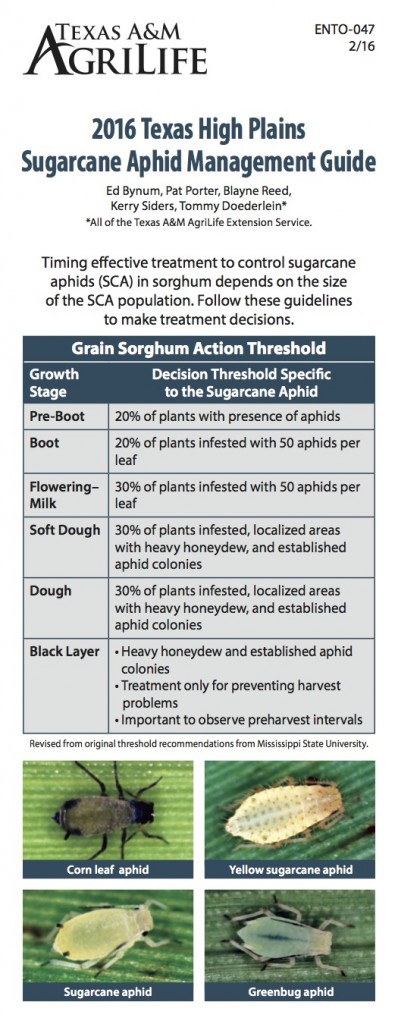
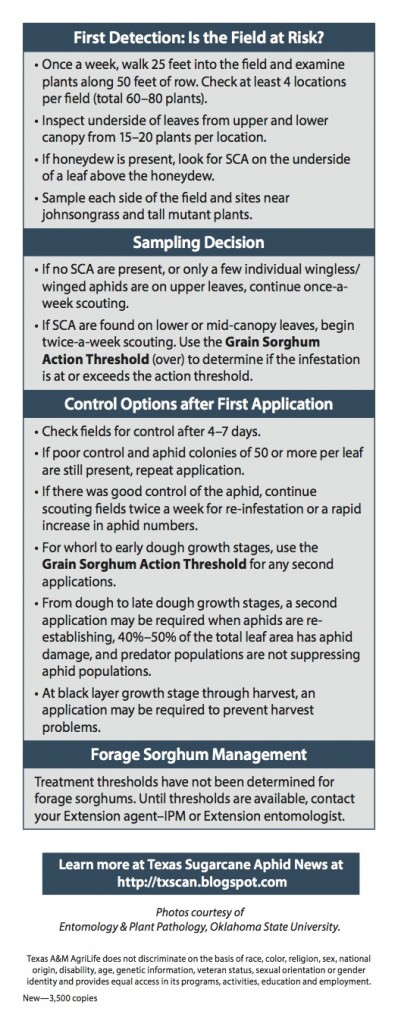
February 23, 2016
Charles Ray Huddleston, TGSA Director, Assumes Role of Sorghum Sector Chairman—Huddleston, from Celina, Texas will take over as chairman at the next USGC meeting in July. Retiring from the board of directors is Bill Kubecka of Palacious, Texas. Huddleston will serve as the sorghum industry’s direct link to the USGC board and will attend all regular board meetings as well as make known the needs of the sorghum industry in dealing with international markets. He has been involved with the US Grains Council for four years as well as serving on both the Texas Grain Sorghum Producers Association and Board. In addition, he has served as county chairman for Collin County Farm Bureau as well as a state director there.
Pecan Farmer wins Water Rights Case—It was a decade in the making but Hondo pecan farmer Glenn Bragg, of the famed Bragg v Edwards Aquifer case was awarded nearly $2.5 million dollars in missed revenue and interest. At the heart of the case was Bragg’s right to the water under his land as a “historic water rights” user. In petitioning the EAA (Edwards Aquifer Authority), the water district that supplies water to cities such as San Antonio, for access to the water under his land, the EAA denied him any access under one petition and limited the other petition to half of what he had asked for. This is the first instance of an individual suing a government entity for damages and winning. The supreme court refused to hear the case and perhaps has set a precedent for years to come as individual water rights come to the forefront of a battle between water hungry public water systems and the land owners that control the rights.
EPA Opens Comment Period on Worker Protection Rules—The U.S. Environmental Protection Agency opened a comment period Tuesday, February 16, on draft “Guidelines for Human Exposure Assessment.” These proposed changes are of particular importance for pesticide workers and handlers as they would be subject to the new regulations beginning January 2017. Read more about potential new rules for agriculture in Delta Farm Press. Comments are due March 22, 2016. To submit a comment, follow this link: https://goo.gl/PnOa5J.
February 11, 2016
Comments Due Today for Transform Section 18–The Environmental Protection Agency (EPA) has opened a brief comment period on a Section 18 application by the Texas Department of Agriculture for use of sulfoxaflor, which goes by the brand name Transform, on up to three million acres of sorghum this growing season to control the sugarcane aphid. The EPA issued a cancellation order for sulfoxaflor in November 2015 in response to a ruling by the Ninth Circuit Court of Appeals. Transform has been an important tool for sorghum producers, used by more than 10 states under the previous Section 18 emergency use exemption. Comments must be submitted by 4 p.m. CST today to be considered. To submit a comment, please follow this link: Sorghum Action Alert.
Over-the-Top Grass Control Approved for Sorghum–The Environmental Protection Agency (EPA) recently announced the registration approval of the active ingredient nicosulfuron (active ingredient in DuPont™ ZEST ™ herbicide) that will complete the ingredient in the non-GMO DuPont™ Inzen™ herbicide tolerant sorghum trait. This product will provide growers with the first ever over-the-top grass control for sorghum. DuPont Pioneer and Advanta US have a joint agreement to commercialize DuPont™ Inzen™ herbicide-tolerant sorghum. DuPont received registration approval Nov. 10 from EPA for tolerances to nicosulfuron and rimsulfuron on sorghum varieties containing the DuPont™ Inzen™ herbicide-tolerant trait, an important first step to the approval for the herbicide ZEST™. As new hybrids become available, the sorghum industry will emphasize best management practices to ensure the long-term viability and sustainability of this technology.
Texas Sorghum Producers attend Annual D.C. Fly-In–Last week, National Sorghum Producers held their annual fly-in in Washington, D.C. Sorghum producers from over a dozen states joined with NSP to raise knowledge and awareness among legislators regarding the sorghum industry and issues farmers are facing. The producers from Texas had a chance to sit down with congressmen and women from each of their districts, including chairman of the House Agriculture Committee, Mike Conaway and the staffs of Senators Ted Cruz and John Cornyn. In each meeting, Texas producers reiterated the importance of stability in agriculture policy and reminded legislators of the far-reaching, real world impacts of over-regulation, unnecessary Farm Bill meddling, and other heavy-handed policy decisions. Each congressman and woman expressed their gratitude at the efforts made by these farmers to get out to The Hill and educate them on the most pressing issues facing agriculture today. In order to ensure the agriculture industry gets its fair political representation, we need constant engagement from authentic voices. This engagement must also occur at the state level, and with less than a year until the next Texas Legislature enters session, we would love to hear what issues you would like to see us work with your representatives to remedy.



